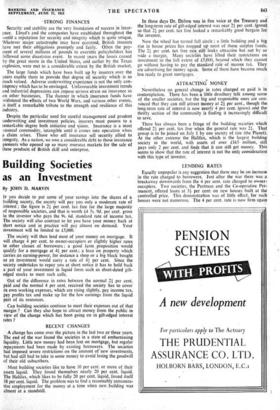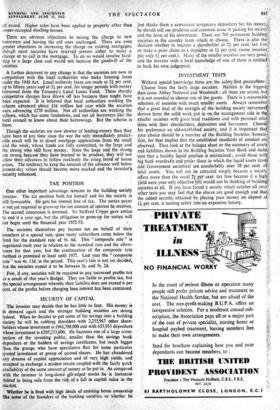Building Societies as an Investment
By JOHN D. MARVIN IF you decide to put some of your savings into the shares of a building society, the society will pay you only a moderate rate of interest ; the figure is 24 per cent. tax free for the large majority of responsible societies, and that is worth £4 5s. 9d. per cent. gross to the investor who pays the 9s. 6d. standard rate of income tax. The society will also contract to let you have your money back at short notice and in practice will pay almost on demand. Your investment will be limited to £5,000.
The society will then lend most of your money on mortgage. It will charge 4 per cent. to owner-occupiers or slightly higher rates to other classes of borrowers ; a good farm proposition would qualify for a mortgage at 45 per cent.; a loan on property which carries an earning power, for instance a shop or a big block bought as an investment would carry a rate of 44 per cent. Since the society undertakes to repay you at short notice it has to hold back a part of your investment in liquid form such as short-dated gilt- edged stocks to meet such calls.
Out of the difference in rates between the normal 24 per cent. paid and the normal 4 per cent. received the society has to cover its own working expenses, which are rising slightly, pay income tax, pay profits tax and make up for the low earnings from the liquid part of its resources.
Can building societies continue to meet their expenses out of that margin ? Can they also hope to attract money from the public in view of the change which has been going on in gilt-edged interest rates ?
RECENT CHANGES A change has come over the picture in the last two or three years. The end of the war found the societies in a state of embarrassing liquidity. Little new money had been lent on mortgage, but regular repayments had been made by existing borrowers. The societies had imposed severe restrictions on the amount of new investments, but had still had to take in some money to avoid losing the goodwill of their old subscribers.
Most building societies like to have 10 per ccnt, or more of their assets liquid. They found themselves nearly 20 per cent. liquid. The Halifax, which likes to be fully 20 per cent. liquid, found itself 38 per cent. liquid. The problem was to find a reasonably remunera- tive employment for the money at a time when new, building was almost at a standstill.
In those days Dr. Dalton was in fine voice at the Treasury and the long-term rate of gilt-edged interest was near 24 per cent. (gross) so that 23 per cent. tax free looked a remarkably good bargain for the investor.
Now the wheel has turned full circle ; a little building and a big rise in house prices has mopped up most of those surplus funds. The 21 per cent. tax free rate still looks attractive but not by so wide a margin. Many societies have lifted their restrictions on investment to the full extent of £5,000, beyond which they cannot go without having to pay the standard rate of income tax. They are advertising for money again. Some of them have become much less ready to grant mortgages.
ATTRACTING MONEY Nevertheless no general change in rates charged or paid is in contemplation. There has been a little desultory talk among some of the smaller societies, but the big and responsible ones are con- vinced that they can still attract money at 23- per cent., though the long-term rate of interest is now nearly 4 per cent. (gross) and the thrifty section of the community is finding it increasingly difficult to save.
There has always been a fringe of the building societies which offered 24 per cent, tax free when the general rate was 23. That group is to be joined on July 1 by one society of size (the Planet). At the other extreme the Halifax, which is the largest building society in the world, with assets of over £165 million, still pays only 2 per cent. and finds that it can still get money. This seems to show that the rate of interest is not the only consideration with this type of investor.
LENDING RATES Equally unpopular is any suggestion that there may be an increase in the rate charged to borrowers. Just after the war there was a breakaway downwards from the 4 per cent. rate charged to owner- occupiers. Two societies, the Portman and the Co-operative Per- manent, offered loans at 34 per cent: on new houses built at the controlled price. This demonstration was of little effect, for such houses were not numerous. The 4 per cent. rate is now firm again all round. Higher rates have been applied to property other than owner-occupied dwelling-houses.
There are obvious objections to raising the charge to new boirowers and leaving the old ones unchanged. There arc even greater objections to increasing the charge on existing mortgages, though most societies have reserved powers either to make a change or to call in the mortgage. To do so would involve hard- ship to a large class and would not increase the goodwill of the societies.
further deterrent to any change is that the societies are now in competition with the local authorities who make housing loans under the 1948 Act. Local authority loans are made at 21 per cent. up to fifteen years and at 31 per cent. for longer periods with money borrowed from the Treasury's Local Loans Fund. These sharply cdmpetitive charges have drawn off less business than might have bein expected. It is believed that local authorities working the scheme advanced about fl6 million last year while the societies were advancing £270 million. Not all authorities are working the scheme, which has some limitations, and not all borrowers like the loial council to know about their borrowings. But the scheme is there.
Though the societies are now shorter of lending-money than they haVe been at any time since the war the only immediately predict- able result will be to divert mortgage applications from the small and the weak, whose funds are fully committed, to the large and the strong who still have money. Since the large and the strong are strong because they have learned to be prudent, they will not allow their advances to follow recklessly the rising trend of house prices. The tendency to keep the amount of the advance well below present-day values should become more marked and the investor's security enhanced.
TAX POSITION One other important advantage remains to the building society investor. The tax position both for himself and for the society is still favourable. He gets his interest free of tax. The surtax payer is not yet required to gross-up the net amount of interest he receives. The second concession is doomed. Sir Stafford Cripps gave notice to end it a year ago, but the obligation to gross-up for surtax will not begin until the financial year 1952-53.
The societies themselves pay income tax on behalf of their members at a special rate, since many subscribers come below the limit for the standard rate of 9s. 6d. This " composite rate " is negotiated each year in relation to the standard rate and the allow- ances for that year, but the continuation of the composite rate method is promised at least until 1957. Last year the " composite rate" was 4s. I Id. in the pound. This year's rate is not yet decided, but the societies expect it to be between 5s. and 5s. 2d.
Few, if any, societies will be required to pay increased profits tax as a result of this year's Budget. They are liable to profits tax, but the special arrangement whereby their liability. does not exceed 6 per Cent. of the profits before charging loan interest has been continued.
SECURITY OF CAPITAL
The investor may decide that he has little to fear. His money is in demand again and the stronger building societies are strong indeed. When he decides to put some of his savings into a building society he will be rubbing shoulders with 2,255,967 other share- holders whose investment is £961,788,000 and with 653,933 depositors whose investment is £205,253,000. He becomes one of a large cross- section of the investing public, smaller than the savings bank depositors or the holders of savings certificates, but much bigger than the groups who have speculative flair for some particular quoted investment or group of quoted shares. He has abandoned any dreams of capital appreciation and of very high yields, and accepted in exchange a modest return coupled with the fairly quick availability of the same amount of money as he put in. As compared with the investor in long-dated gilt-edged stocks he• is fortunate indeed in being safe from the risk of a fall in capital value in the market.
'• Whether he is fired with high ideals of assisting home ownership like some of the founders of the building societies, or whether he just thinks them a convenient temporary depository for his money,i he should still use prudence and common sense in picking his societyl and the form of his investment. There are 769 permanent buildin' societies in the country from which to choose. There is also th decision whether to become a shareholder at 21 per cent, tax fr or stake a prior claim as a depositor at 11 per cent. (some societiet pay only II percent.). Many of the smaller societies arc very goodig, and the investor with a local knowledge of one of them is entitle to back his own judgement.
IN VESTMENT TESTS Without special knowledge these are the safety-first precautions:1 Choose from the fairly large societies. Halifax is the biggest then come Abbey National and Woolwich ; all three are sound, bu it is not essential to choose one of the giants. There is a reasonabl selection of societies with much smaller assets. Always remembe that a great deal of the strength of the building society movemen derives from the solid work put in on the management side in t smaller societies with great local traditions and with personal rela tions with their shareholders, depositors and borrowers. Choo for preference an old-established society, and it is important tha your choice should be a member of the Building Societies Associa tion, for that implies that the established standards of conduct at observed. Then look at the balance sheet or the summary of asset and liabilities shown in the Building Societies Year Book and ma stare that a healthy liquid position is maintained ; avoid those wit big bank overdrafts and prefer those in which the liquid assets (cas and Government securities) are comfortably over 10 per cent. d total assets. You will not be attracted simply because a societ offers more than the usual 21 per cent. tax free because if a hig
yield were your only objective would not be thinking of buildin societies at all. If you have found a society which satisfies all you other tests you may feel that the shares arc good enough and thaci the added security obtained by placing your money on deposit ak.
If per cent. is turning safety into an expensive luxury. r1



















































 Previous page
Previous page